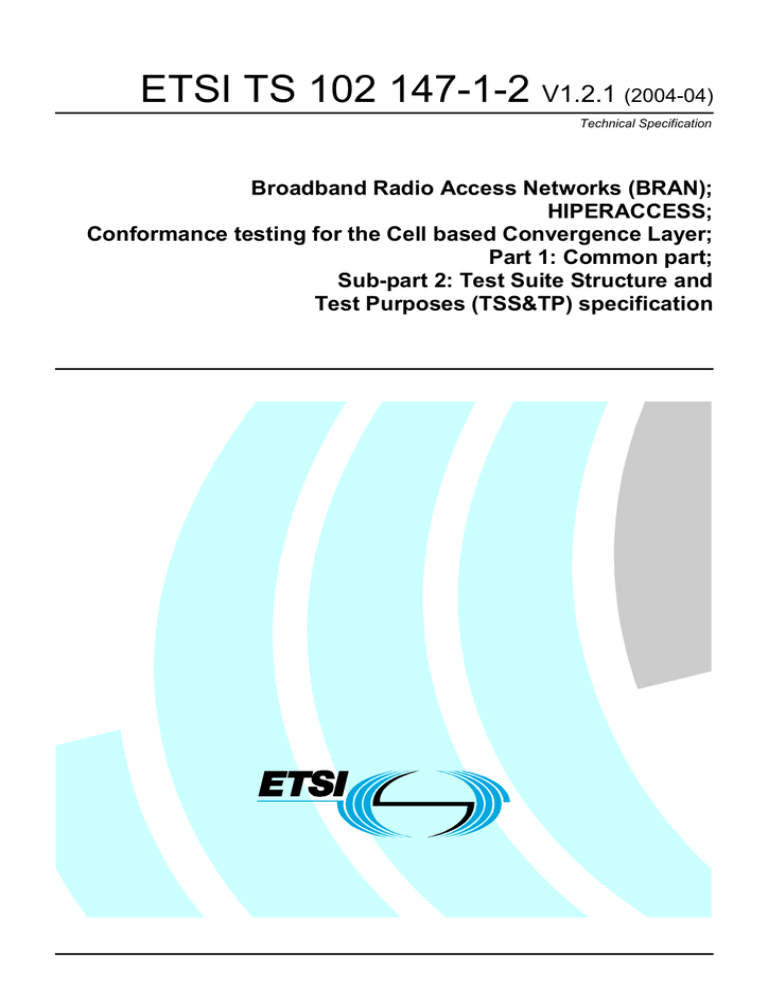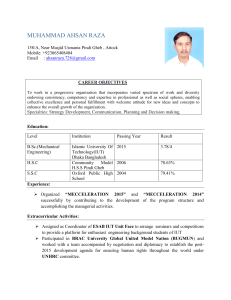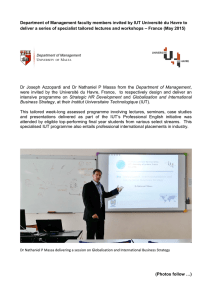
ETSI TS 102 147-1-2 V1.2.1 (2004-04)
Technical Specification
Broadband Radio Access Networks (BRAN);
HIPERACCESS;
Conformance testing for the Cell based Convergence Layer;
Part 1: Common part;
Sub-part 2: Test Suite Structure and
Test Purposes (TSS&TP) specification
2
ETSI TS 102 147-1-2 V1.2.1 (2004-04)
Reference
RTS/BRAN-0034T03-1-2R1
Keywords
access, ATM, broadband, hiperaccess, radio,
testing, TSS&TP
ETSI
650 Route des Lucioles
F-06921 Sophia Antipolis Cedex - FRANCE
Tel.: +33 4 92 94 42 00 Fax: +33 4 93 65 47 16
Siret N° 348 623 562 00017 - NAF 742 C
Association à but non lucratif enregistrée à la
Sous-Préfecture de Grasse (06) N° 7803/88
Important notice
Individual copies of the present document can be downloaded from:
http://www.etsi.org
The present document may be made available in more than one electronic version or in print. In any case of existing or
perceived difference in contents between such versions, the reference version is the Portable Document Format (PDF).
In case of dispute, the reference shall be the printing on ETSI printers of the PDF version kept on a specific network drive
within ETSI Secretariat.
Users of the present document should be aware that the document may be subject to revision or change of status.
Information on the current status of this and other ETSI documents is available at
http://portal.etsi.org/tb/status/status.asp
If you find errors in the present document, send your comment to:
editor@etsi.org
Copyright Notification
No part may be reproduced except as authorized by written permission.
The copyright and the foregoing restriction extend to reproduction in all media.
© European Telecommunications Standards Institute 2004.
All rights reserved.
TM
TM
TM
DECT , PLUGTESTS and UMTS are Trade Marks of ETSI registered for the benefit of its Members.
TM
TIPHON and the TIPHON logo are Trade Marks currently being registered by ETSI for the benefit of its Members.
TM
3GPP is a Trade Mark of ETSI registered for the benefit of its Members and of the 3GPP Organizational Partners.
ETSI
3
ETSI TS 102 147-1-2 V1.2.1 (2004-04)
Contents
Intellectual Property Rights ................................................................................................................................4
Foreword.............................................................................................................................................................4
1
Scope ........................................................................................................................................................5
2
References ................................................................................................................................................5
3
Definitions and abbreviations...................................................................................................................5
3.1
3.2
4
4.1
4.2
4.2.1
4.2.1.1
4.2.2
4.2.2.1
4.2.2.2
4.2.2.3
4.2.2.4
5
5.1
5.1.1
5.1.2
5.1.3
5.2
5.2.1
5.2.2
5.3
5.3.1
5.3.2
Definitions..........................................................................................................................................................5
Abbreviations .....................................................................................................................................................6
Test Suite Structure (TSS)........................................................................................................................6
Structure .............................................................................................................................................................6
Test groups .........................................................................................................................................................6
Protocol groups.............................................................................................................................................6
Common procedures ...............................................................................................................................7
Main test groups ...........................................................................................................................................7
Capability (CA) tests...............................................................................................................................7
Valid Behaviour (BV) tests .....................................................................................................................7
Invalid Behaviour (BI) tests ....................................................................................................................7
Inopportune Behaviour (BO) tests ..........................................................................................................7
Test Purposes (TP) ...................................................................................................................................7
Introduction ........................................................................................................................................................7
TP definition conventions .............................................................................................................................7
TP naming conventions ................................................................................................................................7
Sources of TP definitions..............................................................................................................................8
Test purposes for AP ..........................................................................................................................................8
Procedures at the sender ...............................................................................................................................8
Procedures at the receiver .............................................................................................................................8
Test purposes for AT..........................................................................................................................................9
Procedures at the sender ...............................................................................................................................9
Procedures at the receiver .............................................................................................................................9
Annex A (informative):
Bibliography...................................................................................................10
History ..............................................................................................................................................................11
ETSI
4
ETSI TS 102 147-1-2 V1.2.1 (2004-04)
Intellectual Property Rights
IPRs essential or potentially essential to the present document may have been declared to ETSI. The information
pertaining to these essential IPRs, if any, is publicly available for ETSI members and non-members, and can be found
in ETSI SR 000 314: "Intellectual Property Rights (IPRs); Essential, or potentially Essential, IPRs notified to ETSI in
respect of ETSI standards", which is available from the ETSI Secretariat. Latest updates are available on the ETSI Web
server (http://webapp.etsi.org/IPR/home.asp).
Pursuant to the ETSI IPR Policy, no investigation, including IPR searches, has been carried out by ETSI. No guarantee
can be given as to the existence of other IPRs not referenced in ETSI SR 000 314 (or the updates on the ETSI Web
server) which are, or may be, or may become, essential to the present document.
Foreword
This Technical Specification (TS) has been produced by ETSI Project Broadband Radio Access Networks (BRAN).
The present document is part 1, sub-part 2 of a multi-part covering Broadband Radio Access Networks (BRAN);
HIPERACCESS; Conformance testing for the Cell based Convergence Layer, as identified below:
Part 1:
"Common part";
Sub-part 1:
"Protocol Implementation Conformance Statement (PICS) proforma";
Sub-part 2:
"Test Suite Structure and Test Purposes (TSS&TP) specification";
Sub-part 3:
"Abstract Test Suite (ATS)".
Part 2:
"UNI Service Specific Convergence Sublayer (SSCS)".
ETSI
5
1
ETSI TS 102 147-1-2 V1.2.1 (2004-04)
Scope
The present document contains the Test Suite Structure (TSS) and Test Purposes (TP) to test the TS 102 115-1 [1].
The objective of this test specification is to provide a basis for conformance tests for BRAN HIPERACCESS equipment
giving a high probability of air interface inter-operability between different manufacturer's BRAN HIPERACCESS
equipment.
The ISO standards for the methodology of conformance testing (ISO/IEC 9646-1 [3] and ISO/IEC 9646-2 [4]) as well
as the ETSI rules for conformance testing (ETS 300 406 [2]) are used as a basis for the test methodology.
2
References
The following documents contain provisions which, through reference in this text, constitute provisions of the present
document.
• References are either specific (identified by date of publication and/or edition number or version number) or
non-specific.
• For a specific reference, subsequent revisions do not apply.
• For a non-specific reference, the latest version applies.
Referenced documents which are not found to be publicly available in the expected location might be found at
http://docbox.etsi.org/Reference.
[1]
ETSI TS 102 115-1: "Broadband Radio Access Networks (BRAN); HIPERACCESS; Cell based
Convergence Layer; Part 1: Common Part".
[2]
ETSI ETS 300 406: "Methods for Testing and Specification (MTS); Protocol and profile
conformance testing specifications; Standardization methodology".
[3]
ISO/IEC 9646-1: "Information technology - Open Systems Interconnection - Conformance testing
methodology and framework - Part 1: General concepts".
[4]
ISO/IEC 9646-2: "Information technology - Open Systems Interconnection - Conformance testing
methodology and framework - Part 2: Abstract test suite specification". (See also CCITT
Recommendation X.291 (1991)).
[5]
ISO/IEC 9646-6: "Information technology - Open Systems Interconnection - Conformance testing
methodology and framework - Part 6: Protocol profile test specification".
[6]
ISO/IEC 9646-7: "Information technology - Open Systems Interconnection - Conformance testing
methodology and framework - Part 7: Implementation conformance statement".
3
Definitions and abbreviations
3.1
Definitions
For the purposes of the present document, the terms and definitions given in ISO/IEC 9646-7 [6] and TS 102 115-1 [1]
apply.
ETSI
6
3.2
ETSI TS 102 147-1-2 V1.2.1 (2004-04)
Abbreviations
For the purposes of the present document, the abbreviations given in ISO/IEC 9646-1 [3], ISO/IEC 9646-6 [5],
ISO/IEC 9646-7 [6], TS 102 115-1 [1] and the following apply:
AP
AT
ATM
BI
BO
BRAN
BV
CA
CCP
CL
CPCS
IUT
LAN
PDU
PICS
RS
SS
SSCS
TP
TSS
UNI
VCI
VPI
Access Point
Access Terminal
Asynchronous Transfer Mode
Invalid Behaviour
inopportune Behaviour
Broadband Radio Access Networks (Project)
Valid Behaviour
CApability tests
Cell Common Part
Convergence Layer
Common Part Convergence Sublayer
Implementation Under Test
Local Area Network
Protocol Data Unit
Protocol Implementation Conformance Statement
Receiver Side
Sender Side
Service Specific Convergence Sublayer
Test Purposes
Test Suite Structure
User Network Interface
Virtual Channel Identifier
Virtual Path Identifier
4
Test Suite Structure (TSS)
4.1
Structure
Figure 1 shows the Common CBCL Test Suite Structure (TSS) including its subgroups defined for the conformance
testing.
Test Suite
Protocol group
CCL-AP/ CCL-AT
Protocol subgroup
Common procedures
Sender
Receiver
CA
x
x
Test group
BV
BI
BO
Figure 1: TSS for Hiperaccess Common part CBCL
The test suite is structured as a tree with a first level defined as CCL-AP or CCL-AT representing the protocol group
"Common part CBCL for AP and Common part CBCL for AT".
4.2
Test groups
The test groups are organized in three levels. The first level creates one protocol group representing the protocol
services. The second level separates the protocol services in functional modules. The last level in each branch contains
one or more of the standard ISO subgroups CA, BV, BI and BO.
4.2.1
Protocol groups
The protocol groups identify the common part procedures as defined in TS 102 115-1 [1].
ETSI
7
4.2.1.1
ETSI TS 102 147-1-2 V1.2.1 (2004-04)
Common procedures
The common part procedures group is divided in two functional modules. The first functional module identifies the
procedures at the sender side. The last functional module identifies the procedures at the receiver side.
4.2.2
Main test groups
The main test groups are the capability group, the valid behaviour group, the invalid behaviour group and the
inopportune behaviour group.
4.2.2.1
Capability (CA) tests
This test sub group shall provide limited testing of the major IUT capabilities aiming to insure that the claimed
capabilities are correctly supported, according to the PICS.
4.2.2.2
Valid Behaviour (BV) tests
This test sub group shall verify that the IUT reacts in conformity with the TS, after receipt or exchange of valid Protocol
Data Units (PDUs). Valid PDUs means that the exchange of messages and the content of the exchanged messages are
considered as valid.
4.2.2.3
Invalid Behaviour (BI) tests
This test sub group shall verify that the IUT reacts in conformity with the TS, after receipt of a syntactically invalid
PDU.
4.2.2.4
Inopportune Behaviour (BO) tests
This test sub group shall verify that the IUT reacts in conformity with the TS, after receipt of a syntactically correct
PDU not expected in the actual message exchange.
5
Test Purposes (TP)
5.1
Introduction
5.1.1
TP definition conventions
The TPs are defined following particular rules as shown in table 1.
Table 1: TP definition rules
TP Id according to the TP
naming conventions
TP Id
Reference
Condition
Stimulus
Expected behaviour
5.1.2
Reference.
Initial condition.
Stimulus.
Expected behaviour.
The TP Id is a unique identifier it shall be specified according to the TP naming
conventions defined in the clause 5.1.2.
The reference should contain the references of the subject to be validated by the actual
TP (specification reference, clause, and paragraph).
The condition defines in which initial state the IUT has to be to apply the actual TP.
The stimulus defines the test event to which the TP is related.
Definition of the events that are expected from the IUT to conform to the base
specification.
TP naming conventions
The identifier of the TP is built according to table 2.
ETSI
8
ETSI TS 102 147-1-2 V1.2.1 (2004-04)
Table 2: TP naming convention
Identifier:
TP/<st>/<pg>/<fm>/<x>-<nnn>
<st> = side type
<pg> = protocol group
<fm> = functional module
x
= Type of testing
<nnn> = sequential number
EXAMPLE:
5.1.3
AP
AT
CCP
SS
RS
CA
BV
BI
BO
(000-999)
Access Point
Access Terminal
Cell Common part procedures
Sender side
Receiver side
Capability tests
Valid Behaviour tests
Invalid Behaviour tests
Inopportune Behaviour tests
Test Purpose Number
TP/AT/CCP/RS/BV-010 is the tenth purpose for the valid behaviour testing of the procedures at
the receiver of the common part procedures implemented at the AT side.
Sources of TP definitions
All TPs are specified according to TS 102 115-1 [1].
5.2
Test purposes for AP
5.2.1
Procedures at the sender
TP/AP/CCP/SS/BV-000
TP/AP/CCP/SS/BV-001
TP/AP/CCP/SS/BV-002
TP/AP/CCP/SS/BV-003
5.2.2
Reference: TS 102 115-1 [1], clause 5.3.3.3.
Initial condition: Connection established. IUT is the sender. A loop back mechanism is
implemented on top of either CPCS layer or SSCS layer at the IUT.
Check, that: the IUT manages correctly a continuous stream of CPCS PDU to send.
Reference: TS 102 115-1 [1], clause 5.3.3.3.
Initial condition: Connection established. IUT is the sender. A loop back mechanism is
implemented on top of either CPCS layer or SSCS layer at the IUT.
Check, that: the IUT manages correctly a discontinuous flow of CPCS PDU to send.
Reference: TS 102 115-1 [1], clause 5.3.3.3.
Initial condition: Connection established. IUT is the sender. A loop back mechanism is
implemented on top of either CPCS layer or SSCS layer at the IUT.
Check, that: the IUT manages correctly the mapping between the ATM connection
identifiers (VPI, VCI) and the CID / VCI for each active CID.
Reference: TS 102 115-1 [1], clause 5.3.3.3.
Initial condition: Connection established. IUT is the sender. A loop back mechanism is
implemented on top of either CPCS layer or SSCS layer at the IUT.
Check, that: the IUT sends a CPCS-PDU only if the mapping for the VPI, VCI exists.
Procedures at the receiver
TP/AP/CCP/RS/BV-000
TP/AP/CCP/RS/BV-001
TP/AP/CCP/RS/BV-002
Reference: TS 102 115-1 [1], clause 5.3.3.2.
Initial condition: Connection established. IUT is the receiver. A loop back mechanism is
implemented on top of either CPCS layer or SSCS layer at the IUT.
Check, that: the IUT discards a received CPCS PDU, in case of a non-configured
mapping for the CID and the VCI field.
Reference: TS 102 115-1 [1], clause 5.3.3.2.
Initial condition: Connection established. IUT is the receiver. A loop back mechanism is
implemented on top of either CPCS layer or SSCS layer at the IUT.
Check, that: the IUT manages correctly a continuous stream of received CPCS PDU.
Reference: TS 102 115-1 [1], clause 5.3.3.2.
Initial condition: Connection established. IUT is the receiver. A loop back mechanism is
implemented on top of either CPCS layer or SSCS layer at the IUT.
Check, that: the IUT manages correctly a discontinuous flow of received CPCS PDU.
ETSI
9
5.3
Test purposes for AT
5.3.1
Procedures at the sender
TP/AT/CCP/SS/BV-000
TP/AT/CCP/SS/BV-001
TP/AT/CCP/SS/BV-002
TP/AT/CCP/SS/BV-003
5.3.2
ETSI TS 102 147-1-2 V1.2.1 (2004-04)
Reference: TS 102 115-1 [1], clause 5.3.3.3.
Initial condition: Connection established. IUT is the sender. A loop back mechanism is
implemented on top of either CPCS layer or SSCS layer at the IUT.
Check, that: the IUT manages correctly a continuous stream of CPCS PDU to send.
Reference: TS 102 115-1 [1], clause 5.3.3.3.
Initial condition: Connection established. IUT is the sender. A loop back mechanism is
implemented on top of either CPCS layer or SSCS layer at the IUT.
Check, that: the IUT manages correctly a discontinuous flow of CPCS PDU to send.
Reference: TS 102 115-1 [1], clause 5.3.3.3.
Initial condition: Connection established. IUT is the sender. A loop back mechanism is
implemented on top of either CPCS layer or SSCS layer at the IUT.
Check, that: the IUT manages correctly the mapping between the ATM connection
identifiers (VPI, VCI) and the CID / VCI for each active CID.
Reference: TS 102 115-1 [1], clause 5.3.3.3.
Initial condition: Connection established. IUT is the sender. A loop back mechanism is
implemented on top of either CPCS layer or SSCS layer at the IUT.
Check, that: the IUT sends a CPCS-PDU only if the mapping for the VPI, VCI exists.
Procedures at the receiver
TP/AT/CCP/RS/BV-000
TP/AT/CCP/RS/BV-001
TP/AT/CCP/RS/BV-002
Reference: TS 102 115-1 [1], clause 5.3.3.2.
Initial condition: Connection established. IUT is the receiver. A loop back mechanism is
implemented on top of either CPCS layer or SSCS layer at the IUT.
Check, that: the IUT discards a received CPCS PDU, in case of a non-configured
mapping for the CID and the VCI field.
Reference: TS 102 115-1 [1], clause 5.3.3.2.
Initial condition: Connection established. IUT is the receiver. A loop back mechanism is
implemented on top of either CPCS layer or SSCS layer at the IUT.
Check, that: the IUT manages correctly a continuous stream of received CPCS PDU.
Reference: ETSI TS 102 115-1 [1], clause 5.3.3.2.
Initial condition: Connection established. IUT is the receiver. A loop back mechanism is
implemented on top of either CPCS layer or SSCS layer at the IUT.
Check, that: the IUT manages correctly a discontinuous flow of received CPCS PDU.
ETSI
10
ETSI TS 102 147-1-2 V1.2.1 (2004-04)
Annex A (informative):
Bibliography
•
ITU-T Recommendation X.290: "OSI conformance testing methodology and framework for protocol
Recommendations for ITU-T applications - General concepts".
ETSI
11
History
Document history
V1.1.1
November 2002
Publication
V1.2.1
April 2004
Publication
ETSI
ETSI TS 102 147-1-2 V1.2.1 (2004-04)



